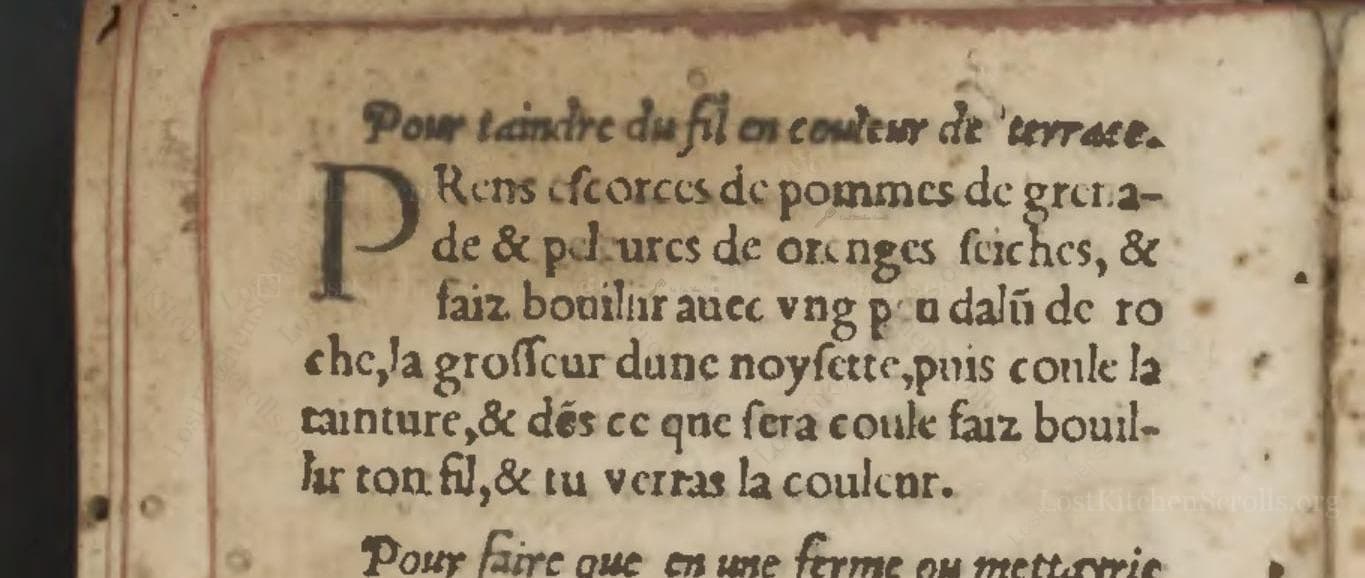Pour Taindre Du Fil En Couleur De Terrace
"To Dye Thread In Terrace Color"
From the treasured pages of Bastiment de receptes
Unknown Author

Pour Taindre Du Fil En Couleur De Terrace
"Prens escorces de pommes de grenade & pelures de oranges seiches, & faiz bouillir auec vng peu dalun de roche, la groffeur dune noysette, puis coule la tainture, & des ce que sera coule faiz bouillir ton fil, & tu verras la couleur."
English Translation
"To dye thread in terrace color. Take pomegranate rinds and dried orange peels, and boil them with a little rock alum, about the size of a hazelnut; then strain the dye, and as soon as it is strained, boil your thread in it, and you will see the color."
Note on the Original Text
The recipe is written in plain, direct Old French, intended for practical domestic use. Quantities are measured by comparison—'the size of a hazelnut'—since standardized weighing was rare for household recipes. Spelling varies across manuscripts: 'taindre' for 'teindre' (to dye), 'dalun' for 'd'alun' (of alum), and no standardized punctuation, so the instructions run together. The recipe assumes familiarity with boiling and dyeing processes, omitting detailed times and temperatures. The ingredient names reflect the era's trade connections—pomegranate and orange peels were valued both for dye and medicinal uses.

Title
Bastiment de receptes (1541)
You can also click the book image above to peruse the original tome
Writer
Unknown
Era
1541
Publisher
A Lescu de Coloigne
Background
Step into the culinary secrets of Renaissance France! 'Bastiment de receptes' is a delectable compendium newly translated from Italian, brimming with recipes, curious odors, and medicinal tidbits designed to both delight the palate and preserve health.
Kindly made available by
Library of Congress
This recipe hails from the early French Renaissance and was published in 1541 in Lyon by the Frellon family. The book was a practical compendium, newly translated from Italian, combining advice on perfumes, dyeing, household preparations, and even health remedies. Such recipes were intended for both amateur artisans and housekeepers looking to produce colored textiles at home, making the secrets of the dye house accessible to well-to-do urban households. Natural dyes like pomegranate and citrus were widely used across Europe before the advent of synthetic colors. The terra cotta hue produced here would have been fashionable for decorative household textiles, embroidery, or even garment trim, connecting the user directly with the color preferences and available materials of the 16th century.

Back in 1541, this recipe would have been prepared over a wood or charcoal fire, using a clay or metal pot for boiling the plant material. Straining the dye would be done through a coarse linen cloth or sieve. Thread was likely wool or cotton, wound into hanks for even dyeing. Alum, purchased from an apothecary, was the essential fixative or 'mordant.' Wooden sticks or tongs would be used to stir and remove the hot, freshly dyed threads.
Prep Time
5 mins
Cook Time
1 hr 30 mins
Servings
1
We've done our best to adapt this historical recipe for modern kitchens, but some details may still need refinement. We warmly welcome feedback from fellow cooks and culinary historians — your insights support the entire community!
Ingredients
- 0.7oz dried pomegranate peel (or fresh, if unavailable dried)
- 0.7oz dried orange peel (or fresh zest as substitute)
- 0.18oz rock alum (potassium aluminum sulfate; can substitute with regular alum from spice shops)
- 6.8fl oz water
- 1.8–3.5oz thread (wool or cotton, undyed)
Instructions
- To dye thread a terra cotta color, take about 0.7 ounces of dried pomegranate peels and 0.7 ounces of dried orange peels.
- Place them in a small pot, add 6.8 fluid ounces of water, and bring to a boil.
- Add a small piece of rock alum, about the size of a hazelnut (roughly 0.18 ounces).
- Let everything simmer for at least 20-30 minutes to extract the color.
- Strain the mixture to remove the peel pieces, reserving the dye liquid.
- Place your thread (preferably wool or cotton, pre-wetted) into the boiling dye bath.
- Simmer for another 30-60 minutes, stirring occasionally, until the thread takes on a warm, earthy tone.
- Rinse the dyed thread in cool water and let it dry.
Cooking Estimates
It takes a few minutes to prepare and measure the ingredients. You will simmer the ingredients for about 20-30 minutes to make the dye, then simmer the thread in the dye bath for another 30-60 minutes. There are practically no calories because you do not eat this product.
As noted above, we have made our best effort to translate and adapt this historical recipe for modern kitchens, taking into account ingredients nowadays, cooking techniques, measurements, and so on. However, historical recipes often contain assumptions that require interpretation.
We'd love for anyone to help improve these adaptations. Community contributions are highly welcome. If you have suggestions, corrections, or cooking tips based on your experience with this recipe, please share them below.
Join the Discussion
Rate This Recipe

Den Bockfisch In Einer Fleisch Suppen Zu Kochen
This recipe hails from a German manuscript cookbook compiled in 1696, a time whe...

Die Grieß Nudlen Zumachen
This recipe comes from a rather mysterious manuscript cookbook, penned anonymous...

Ein Boudain
This recipe comes from an anonymous German-language manuscript cookbook from 169...

Ein Gesaltzen Citroni
This recipe, dating from 1696, comes from an extensive anonymous German cookbook...
Browse our complete collection of time-honored recipes



